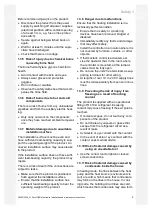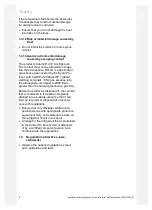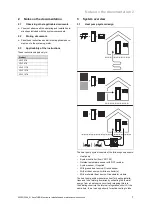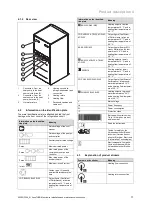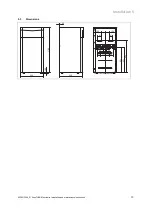
7 Filling and purging the system
18
Installation and maintenance instructions flexoTHERM exclusive 0020213394_01
▶
If you ascertain that it contains magnetite, clean the sys-
tem and apply suitable corrosion-protection measures, or
fit a magnet filter.
▶
Check the pH value of the removed water at 25 °C.
▶
If the value is below 8.2 or above 10.0, clean the system
and treat the heating water.
▶
Ensure that oxygen cannot get into the heating water.
Checking the filling and supplementary water
▶
Before filling the system, measure the hardness of the
filling and supplementary water.
Treating the filling and supplementary water
▶
Observe all applicable national regulations and technical
standards when treating the filling and supplementary
water.
Provided the national regulations and technical standards
do not stipulate more stringent requirements, the following
applies:
You must treat the heating water in the following cases:
–
If the entire filling and supplementary water quantity dur-
ing the operating life of the system exceeds three times
the nominal volume of the heating installation, or
–
If the guideline values listed in the following table are not
met, or
–
If the pH value of the heating water is less than 8.2 or
more than 10.0.
Total
heating
output
Water hardness at specific system volume
1)
≤
20 l/kW
> 20 l/kW
≤
50 l/kW
> 50 l/kW
kW
ppm
CaCO
₃
mol/
m
³
ppm
CaCO
₃
mol/
m
³
ppm
CaCO
₃
mol/
m
³
< 50
< 300
< 3
200
2
2
0.02
> 50
to
≤
200
200
2
150
1.5
2
0.02
> 200
to
≤
600
150
1.5
2
0.02
2
0.02
> 600
2
0.02
2
0.02
2
0.02
1) Nominal capacity in litres/heating output; in the case of multi-
boiler systems, the smallest single heating output is to be used.
Caution.
Risk of material damage if the heating
water is treated with unsuitable additives.
Unsuitable additives may cause changes in
the components, noises in heating mode and
possibly subsequent damage.
▶
Do not use any unsuitable frost and cor-
rosion protection agents, biocides or seal-
ants.
No incompatibility with our products has been detected to
date with proper use of the following additives.
▶
When using additives, follow the manufacturer's instruc-
tions without exception.
We accept no liability for the compatibility of any additive or
its effectiveness in the rest of the heating system.
Additives for cleaning measures (subsequent
flushing required)
–
Fernox F3
–
Sentinel X 300
–
Sentinel X 400
Additives intended to remain permanently in the
system
–
Fernox F1
–
Fernox F2
–
Sentinel X 100
–
Sentinel X 200
Additives for frost protection intended to remain
permanently in the system
–
Fernox Antifreeze Alphi 11
–
Sentinel X 500
▶
If you have used the above-mentioned additives, inform
the operator about the measures that are required.
▶
Inform the operator about the measures required for frost
protection.
7.1.2
Filling and purging the heating installation
1.
Open all of the thermostatic radiator valves on the heat-
ing installation and, if required, all other stop valves.
2.
Check all of the connections and the entire heating in-
stallation for leaks.
1
3.
Push the white switching lever
(1)
on the motor head
of the diverter valve until it engages in its mid-position
in order to move the heating/cylinder charging diverter
valve into the mid-position.
◁
Both valves are open and the filling procedure is
improved since the air in the system can escape.
4.
Connect a filling loop to the hot water supply.
5.
Remove the screw cap from the filling and drain valve
for the heating circuit and fasten the free end of the
filling loop to the valve.
6.
Open the filling and drain valve for the heating circuit.
7.
Open the heating water supply slowly.
8.
Fill with water until the pressure gauge (on-site) shows
that the heating installation has reached a pressure of
approx. 1.5 bar.
9.
Close the filling and drain valve for the heating circuit.
10. Purge the heating circuit at the locations provided for
this.
11. Purge the heating pump using the heating pump's drain
screw.


